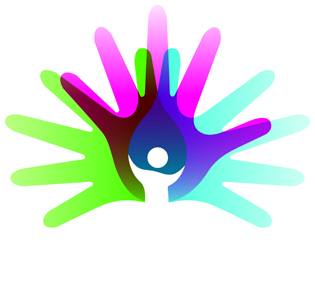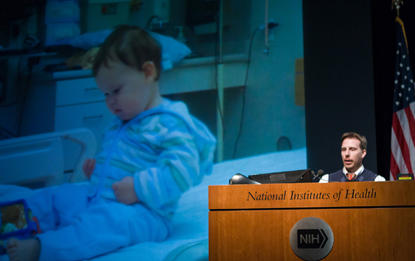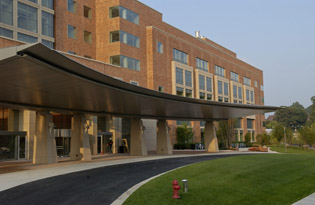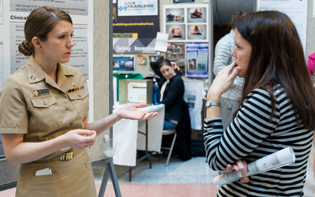NIH Rare Disease Day
Teamwork of Scientists and Community Brings Treatment to Fruition

EURORDIS
Trip after trip to the doctor. Misdiagnosis followed by confusion. More visits to specialists. Few, if any, answers. For those with a rare disease, this cycle of uncertainty rarely ends even with a diagnosis. Of the more than 6,000 known rare diseases, only 300 have any treatment at all. Nevertheless, with a diagnosis of a rare disorder comes a community of patients and their families, as well as scientists, clinicians, and others, all traveling the same path together.
More than 500 members of that rare-disease community gathered at NIH—and an additional 329 watched online—on February 27, 2015, for the international Rare Disease Day symposium, which highlighted recent progress in bringing new therapies to the clinic. For rare diseases, such progress depends on tight collaboration among researchers, clinicians, regulatory agencies, advocacy organizations, and most of all, patients, their families, and other caregivers.
“Translation is a team sport,” said Christopher Austin, director of the National Center for Advancing Translational Sciences (NCATS). But “that is easier said than done.”

DANIEL SONE, NCI
NCATS Director Christopher Austin told how in response to several groups of parents asking for help for their children with Niemann-Pick type C disease, NCATS put together a team of scientists, advocacy and patient organizations, and industry partners, to develop a therapeutic medication. Clinical trials are now underway.
A rare disease is defined as one that affects fewer than 200,000 people in the United States–about one in every 1,500. But with 5,000 to 7,000 rare diseases known so far, “Having a rare disease is not so rare,” said NIH Clinical Center Director John Gallin. “It’s about 10 percent of our population.”
The NIH Clinical Center plays an important role in the study of these diseases. “We have an unusual ability to assemble cohorts of patients with rare diseases,” Gallin continued. In fact, the day of the symposium, the Clinical Center’s tally included studies of 584 different rare diseases, with 948 clinical protocols and more than 30,000 patients with rare diseases.
Rare-diseases research, although critical for patients and families desperately awaiting treatments, has a long history of coming up with new therapies for common diseases. For example, William H. Theodore (National Institute of Neurological Disorders and Stroke) described how his work on the rare metabolic disorder succinic semi-aldehyde dehydrogenase deficiency has led to a possible new drug—now in clinical trials—that targets the pathway of neurons that produce gamma–aminobutyric acid and may also benefit patients with Down syndrome.
Likewise, Gallin’s lab recently made a discovery about an abnormality in a rare inherited immunodeficiency disorder that may lead to a therapy to prevent atherosclerosis. The disorder is chronic granulomatous disease (CGD) in which certain immune system cells are unable to kill some types of bacteria and fungi. In CGD, an abnormality of the enzyme nicotinamide adenine dinucleotide phosphate oxidase (NADPH oxidase) results in reduced phagocyte production of reactive oxygen species and related products such as hydrogen peroxide and hypochlorous acid (bleach). Studies at the NIH and elsewhere have helped to define supportive therapy for CGD with use of interferon-gamma and prophylactic antibiotics such as Bactrim and intraconazole. Some patients have been cured with bone-marrow transplantation. In addition, gene therapy is an area of intense investigation.
Gallin’s lab found that the loss of NADPH oxidase function in CGD is protective against developing carotid artery atherosclerosis (Circulation 130:2031-2039, 2014). It’s possible, therefore, that NADPH oxidase might be a therapeutic target for atherosclerosis in normal subjects. Thus, CGD is an example, said Gallin, of “a rare disease providing insights into a common disease.”
As with many common diseases, there are significant scientific, financial, and organizational gaps between discovery and effective treatments. For some rare diseases, advocacy organizations, parents, and caregivers have helped cross this gap, recruiting and galvanizing patient cohorts or forming nonprofits and even virtual biotech organizations to catalyze the transition from the lab to the clinic. Matt Might, the parent of the first child diagnosed with N-glycanase deficiency, found that a critical bottleneck was locating a cohort of patients–both for the science and for moral support.

DANIEL SONE, NCI
Matt Might, the parent of the first child diagnosed with N-glycanase deficiency, found that a critical bottleneck was locating a cohort of patients–both for the science and for moral support. His blog post received millions of views and he was able to find about a dozen children from around the world with the same disease. He brought them to the NIH for a natural-history clinical trial.
Might talked about his and his wife’s efforts to build a community; he even wrote a blog post about his son’s rare disease that received millions of views in a few weeks. He was able to find about a dozen children from around the world with the same disease. He brought them to the NIH for a natural-history clinical trial. “We are pushing every living patient with this disorder through the NIH.”
For other rare diseases, the science is there, but the critical path to clinical trial has proven elusive. Jill Wood is the mother of a child diagnosed with Sanfilippo syndrome, a disease that causes behavioral and motor problems. Frustrated by the lack of treatment options, she formed a nonprofit organization to fund and stimulate research. But then she found herself at an impasse.
“Okay, the science is here now,” she said. “We’re gonna have a treatment, [but] we’re still ultra rare. Nobody’s come knocking on my door, saying, ‘Oh, can I sponsor your clinical trial? Can I take your treatment to market?’” Rather than wait for outside assistance, she formed a virtual biotech company to shepherd her treatment through its first clinical trial.
Beginning in 2011, NCATS began taking on the challenge of bridging the gap between bench research and clinical trials. Austin shared a recent success story of bringing a therapeutic medication to the clinic for Niemann-Pick disease type C, a lipid-storage disease characterized by progressive neurodegeneration.
“It started when several separate groups of parents walked into my office and asked if there was something we could do to help to develop a treatment for Niemann-Pick C disease during the lifetimes of their children,” Austin said. Working from there, the Therapeutics for Rare and Neglected Diseases (TRND) program at NCATS recruited a diverse team that included intramural and extramural scientists, advocacy and patient organizations, and industry partners. Human clinical trials for a new therapeutic for Niemann-Pick type C, 2-hydroxypropyl-beta-cyclodextrin, are currently ongoing, supported by the pharmaceutical company Vtesse (Gaithersburg, Maryland).
“We are still working on what the secret sauce is that goes into this,” said Austin. “But I can tell you one of the things that’s absolutely clear is that this is due to teamwork; this is due to mutually dependent, mutually trusting relationships.”
Stephen Seiler, from AesRX, LLC (now part of Baxter Pharmaceuticals in Reston, Virginia), is working with the TRND program to develop the only treatment made specifically for sickle-cell anemia. He emphasized the complex orchestration required to get a drug from the lab to the patient as “a multistage, multi-institute, public-private translational-research collaboration [that] was catalyzed by TRND funding.”
The tricky bit was traversing the “biotech valley of death,” the gap between discovery and the first clinical trial. Many translational projects flounder due to lack of funding. “Then we’d find a big pharma partner who would now take this de-risked program the rest of the way,” Seiler continued. “You’ve got to imagine the endgame here if you really want to get a drug to patients.” With the support of TRND and the rest of the research-collaboration partners, Aes-103 (5-hydroxymethylfurfural) has crossed that chasm and has been taken up by Baxter Pharmaceuticals for further development.

NIH CLINICAL CENTER
The NIH Clinical Center plays an important role in the study of these diseases. Its tally includes studies of 584 different rare diseases, 948 clinical protocols, and more than 30,000 patients with rare diseases.
Robert Kotin, formerly a senior investigator in the National Heart, Lung, and Blood Institute (NHLBI) and now an inventor and vice president of production at Voyager Therapeutics, Inc. (Cambridge, Massachusetts), described a similar success story in his quest to deliver effective gene therapies to patients. Adeno-associated virus vectors (AAVs) have long been available for research, but producing the quantities required for human-scale gene therapy was a problem Kotin decided to tackle. While studying virus replication, he made a discovery that allowed him to produce recombinant AAV in the large quantities needed for human trials. Through the NIH and NHLBI technology-transfer offices, the NIH was able to secure patents and move clinical trials forward.
This technology has been licensed by uniQure (Amsterdam, Netherlands) that has recently gotten approval for their lipoprotein lipase deficiency treatment, Glybera. Généthon (Évry, France) also licensed it in hopes of using Kotin’s AAV technology to combat Duchenne muscular dystrophy, a severe and rapidly progressing form of muscular dystrophy.
“It takes enormous talent [and] investment of time and money, and some serendipity helps along the way; and we need to depend on our whole ecosystem of private and public investment,” said NIH Director Francis Collins. When it comes to developing new treatments for any disease, the road is difficult, but helping patients with rare diseases represents a larger challenge.
Rare Disease Day “puts faces to names and [lets us] hear firsthand how better we can collaborate to deliver the types of 21st-century cures the community anxiously awaits,” said United States Congressman Leonard Lance (R-N.J.), co-chair of the Rare Disease Congressional Caucus. “There’s a lot of work to do, but we shall do it together.”
To watch an archived videocast of Rare Disease Day, go to http://videocast.nih.gov/launch.asp?18871.
SELECTED GLOSSARY OF RARE DISEASES
Succinic semi-aldehyde dehydrogenase deficiency
Cause: Autosomal recessive mutation in the ALDH5A1 gene, which encodes a protein that breaks down the gamma–aminobutyric acid neurotransmitter.
Symptoms: developmental and speech delay, neurological problems, decreased muscle tone
Prevalence: 350 patients worldwide
Discovery: 1981 by researchers at University of California, San Diego (La Jolla, Calif.)
Source: http://ghr.nlm.nih.gov/condition/succinic-semialdehyde-dehydrogenase-deficiency
N-Glycanase deficiency
Cause: mutation in the NGLY1 gene, which encodes a protein important for breakdown of misfolded glycoproteins
Symptoms: developmental delay, neurologic impairment, liver disease, and lack of tears
Prevalence: 17 patients worldwide
Discovery: 2012 by researchers at Duke University (Durham, N.C.)
Source: http://www.ngly1.org/p/about.html

DANIEL SONE, NCI
The Rare Disease Day poster session presented opportunities for attendees to learn more about rare-disease research being conducted at NIH.
Sanfilippo syndrome
Cause: Autosomal recessive deficiency in enzymes that break down glycosaminoglycans (long-chain sugar molecules)
Symptoms: Decline in learning abilities and behavioral, walking, and sleep problems appear between ages 2 and 6
Prevalence: 1 in 70,000 births
Discovery: 1963 by Dr. Sylvester Sanfilippo at the University of Minnesota Medical School (Minneapolis)
Source: http://www.nlm.nih.gov/medlineplus/ency/article/001210.htm
Lipoprotein lipase deficiency
Cause: defective gene in lipoprotein lipase, leads to buildup of fat in the blood
Symptoms: Abdominal and muscle pain, nausea, vomiting, and low appetite
Prevalence: 1 in 1,000,000 people worldwide
Discovery: 1932 described by Drs. Burger and Grutz
Source: http://www.nlm.nih.gov/medlineplus/ency/article/000408.htm
Duchenne muscular dystrophy
Cause: X-linked defective gene for dystrophin causes rapid muscle-cell turnover
Symptoms: Progressive loss of muscle strength, fatigue, intellectual and learning disabilities
Prevalence: 1 in 3,600 male infants
Discovery: 1987 by researchers at Harvard Medical School, Howard Hughes Medical Institute Children’s Hospital, and Massachusetts General Hospital (Boston)
Source: http://www.nlm.nih.gov/medlineplus/ency/article/000705.htm
Niemann-Pick disease type C
Cause: Defective NPC1 or NPC2 gene leads to accumulation of cholesterol and other lipids in the lysosome
Symptoms: Jaundice, enlarged spleen or liver, and progressive neurodegeneration
Prevalence: ~500 patients worldwide
Discovery: NPC1 gene discovered in 1997 by intramural scientists at NHGRI
Source: http://www.ninds.nih.gov/disorders/niemann/niemann.htm
Sickle-cell disease
Cause: mutation in the HBB gene, which encodes hemoglobin subunit beta. Red blood cells have an abnormal shape that affects their ability to clot and carry oxygen
Symptoms: Anemia, chronic pain, and blood-vessel occlusion
Prevalence: 70,000–80,000 people in the United States, but worldwide 1 in 300,000 babies born per year
Discovery: 1910 first described by James Herrick; in 1949 Linus Pauling characterized the abnormal hemoglobin molecule
Sources: http://www.nhlbi.nih.gov/health/health-topics/topics/sca; http://ghr.nlm.nih.gov/condition/sickle-cell-disease
Chronic granulomatous disease
Cause: Mutations in genes for subunits of the reduced form of nicotinamide adenine dinucleotide phosphate oxidase complex
Symptoms: Inflammation, immunodeficiency, and chronic infections
Prevalence: 1 in 200,000 people worldwide
Discovery: 1957 by clinicians at the University of Minnesota Hospitals
Source: http://ghr.nlm.nih.gov/condition/chronic-granulomatous-disease
Down syndrome (common disease)
Cause: extra copy of chromosome 21
Symptoms: Developmental and growth delays, intellectual disabilities
Prevalence: 1 in 830 births
Discovery: First described by John Down in 1866, but genetic causes discovered in 1959 by Jerome Lejeune; both were physicians
Source: http://ghr.nlm.nih.gov/condition/down-syndrome
This page was last updated on Monday, April 25, 2022
